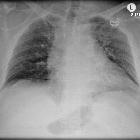Chest (supine view)



The supine anteroposterior chest view is the alternative to the PA view and the AP erect view when the patient is generally too unwell to tolerate standing, leaving the bed, or sitting . The supine view is of lesser quality than both the AP erect and the PA view for many reasons, yet sometimes it is the only imaging available to the patient.
Indication
The supine view examines the lungs, bony thoracic cavity mediastinum and great vessels. This particular chest X-ray is often used frequently to aid diagnosis of acute trauma abnormalities, or chronic conditions in intensive care units and wards.
It is important to note that the supine projection will produce a magnified mediastinal shadow due to the increased distance of the heart from the image receptor and beam divergence (see figure 1 AP supine and figure 2 PA projection of the same patient).
Patient position
- patient is supine
- an image receptor is placed under the patient's chest via a tray, sliding sheet, cassette holder, or an assisted log roll
- the chin is raised (if possible) as to be out of the image field
- if possible, the hands are placed by the patient's side
- any leads or lines that can be moved should be transferred out of the image area to improve image quality
Technical factors
- anteroposterior projection
- suspended inspiration
- centering point
- the level of the 7th thoracic vertebra, approximately 7 cm below the jugular notch of the sternum
- collimation
- superiorly 5 cm above the shoulder joint to allow proper visualization of the upper airways
- inferior to the inferior border of the 12th rib
- lateral to the level of the acromioclavicular joints
- orientation
- portrait or landscape
- detector size
- 35 cm x 43 cm or 43 cm x 35 cm
- exposure
- 100-110 kVp
- 4-8 mAs
- SID
- 180 cm
- grid
- yes (this may be departmentally dependent)
Image technical evaluation
The entire lung fields should be visible from the apices down to the lateral costophrenic angles:
- the chin should not be superimposing any structures
- sternoclavicular joints are equal distant apart
- the clavicle is in the same horizontal plane
- a minimum of eight posterior ribs is visualized above the diaphragm
- the ribs and thoracic cage are seen only faintly over the heart
- clear vascular markings of the lungs should be visible
Practical points
This projection can be very challenging in emergency situations; clear communication is the key to ensuring your patient gets the best image possible under the situation at hand.
The supine view, although a supplementary projection for the PA comes with a wide range of technically challenging factors and is hence inferior.
The phase of respiration has a profound effect on the appearance of several structures on the chest radiograph. A poor-inspiratory AP radiograph can mimic pathology. Structures that can appear different on expiration include:
- heart size
- mediastinal contours and width
- lung inflation
- diaphragm contours
Rotation of a chest radiograph can mimic common pathology processes and make it hard to produce an appropriate diagnosis.
The supine view is used to investigate a plethora of conditions and it is the radiographer's responsibility to ensure high-quality diagnostic images are achieved consistently.
The sternoclavicular joints are a sound indicator for positional rotation, if one sternoclavicular joint is notably wider than the other, that respected side needs to be rotated away from the image receptor to correct rotation.
Patients with a long-standing history of emphysema or COPD will have abnormally long lungs compared to the general population, remember this when collimating superior to inferior.
Side marker placement is imperative; patients can have congenital conditions that mimic a mirrored image .
Remember to explain to your patient what you are about to do; that is ask them to take a breath in and hold it. Many times this gives the patient time to prepare and results in a better breath hold and therefore a higher quality radiograph.
Always remember to tell your patient to breathe again!

